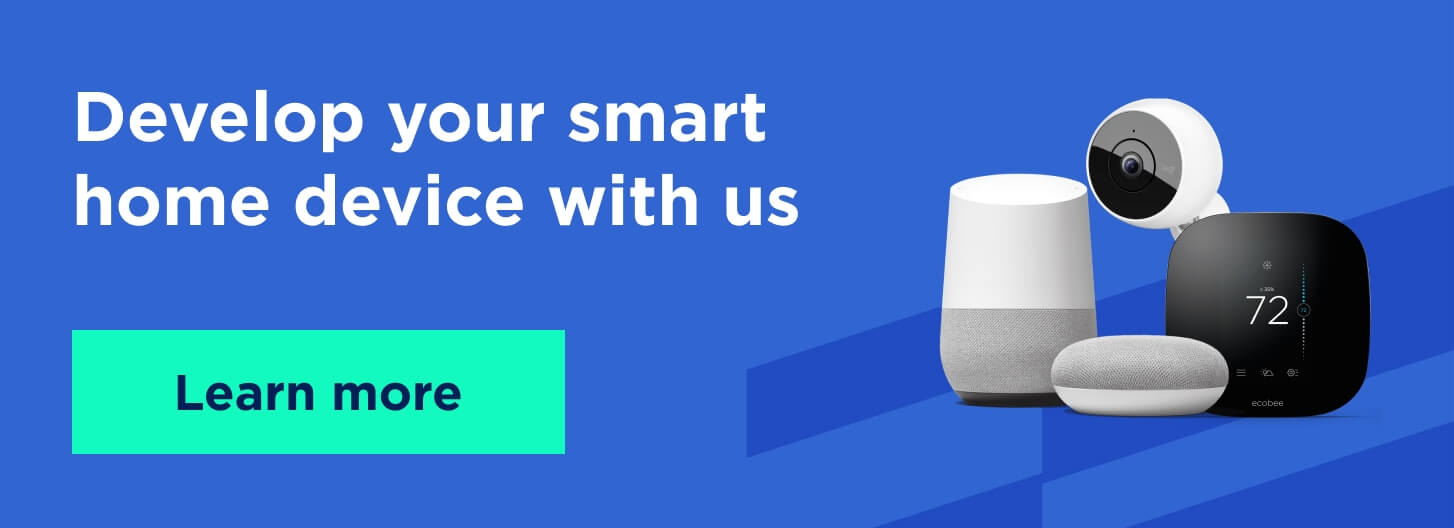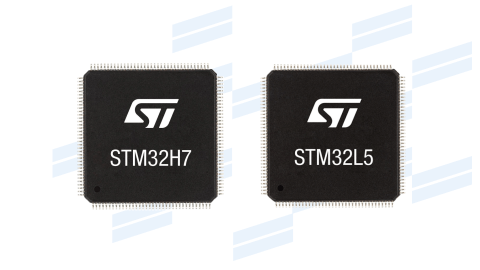Entering the smart home industry can be an uphill climb if you don’t know what smart home communication protocols to use for your project. A smart home device won’t work properly without the right protocol that will enable its integration into a smart home ecosystem. Otherwise, you risk hardware and software not meeting your end users’ expectations. Poor protocol choice can lead to low battery lifetime, insufficient signal range, or unstable connection.
This article provides a convenient overview of smart home communication protocols, their benefits, limitations, and security, as well as how to choose the right one. Check out more!
What is a smart home protocol?
A smart home protocol is a set of standards that determine how devices within a smart home ecosystem communicate. It acts as a device’s language, enabling it to interact seamlessly with other smart home solutions and exchange information. The primary purpose of a smart home protocol is to ensure interoperability and compatibility between devices of different vendors. Without a standardized protocol, devices manufactured by different vendors won’t communicate, which limits the functionality of the smart home environment.
Communication protocols help with authentication data transmission, and error detection and correction. Moreover, they ensure that devices can exchange information reliably and securely.
The most common smart home protocols include Z-Wave, ZigBee, Wi-Fi, Bluetooth Low Energy (BLE), Ethernet, Thread, and Matter. Let’s take a closer look at each of them.
7 most commonly used IoT protocols compared
Explore a table with concise explanations of the differences between smart home protocols we cover in this article, including their power efficiency, benefits, limitations, security, and use cases.
| Communication protocol | Benefits | Limitations | Security | Use cases |
|---|---|---|---|---|
| Ethernet | High bandwidth, fast and reliable connection, eliminated risk of network interference | Requires cable connection | Any protocol over Ethernet enables its security | Smart TVs, gaming consoles, media streaming devices |
| Wi-Fi | Widely supported, extensive coverage, perfect for data-intensive devices | May interfere with devices that operate on different frequencies, Wi-Fi devices consume more power | WPA2 and WPA encryption | Video and music streaming devices, printers |
| Bluetooth/BLE | Perfect for battery-powered smart home devices, efficient data transferring, direct device-to-device communication | Limited coverage area and data transfer rates | AES-CCM encryption | Smart locks, sensors, light bulbs, smart speakers |
| Zigbee | Suitable for mesh networking, reliable communication | Limited range | AES-128 standard | Smart lighting, thermostats, sensors |
| Z-Wave | Self-healing network structure | Limited compatibility with third-party devices | AES-128 encryption | Smart lighting, security systems, smart thermostats |
| Thread | Ensures scalability, suitable for battery-powered devices | Limited device availability | Built-in security layer | Smart plugs, sensors |
| Matter | Ensures compatibility between smart home protocols | Requires certification | AES-128 encryption | Sensors, smart lighting, smart thermostats |
Now, let’s talk about each of these protocols in more detail to help you with the choice. You can also contact Lemberg Solutions directly for consulting.
1. Ethernet

About technology
Ethernet is a wired communication technology commonly used for local area networks (LANs). It operates via twisted pair and fiber-optic cables to transmit data at high speed. Ethernet follows the IEEE 802.3 standard and supports reliable and secure data transmission over a network.
Benefits
Ethernet provides a stable and robust connection for smart home devices. Due to high bandwidth, Ethernet is suitable for devices that require a fast and reliable Internet connection, such as smart TVs, gaming consoles, and media streaming devices, as well as for devices that operate within a local network. Ethernet connections also eliminate the risk of network interference, ensuring reliable communication between devices.
Limitations
Ethernet requires running cables throughout the home, which can be burdensome for end users. Therefore, Ethernet is the most suitable option when wired connections are already in place.
Security
Ethernet doesn’t offer a high level of security for the smart home ecosystem. However, it ensures secure data transmission via other protocols that work over Ethernet.
2. Wi-Fi

About technology
Wi-Fi is a wireless communication technology that allows devices to connect to a network via radio waves. It follows the IEEE 802.11 standard and operates on different frequency bands, from 2.4 GHz to 5 GHz. Wi-Fi is one of the most popular smart home wireless protocols.
Benefits
Wi-Fi is highly versatile and widely supported, which makes it suitable for a broad range of smart home devices. It provides an extensive coverage, enabling devices to connect from different spots within home. Wi-Fi provides the bandwidth sufficient for data-intensive devices (e.g., video streaming).
Limitations
Wi-Fi can interfere with devices that operate on different frequencies as well as obstacles like walls or furniture, which may affect signal strength and coverage. Additionally, Wi-Fi devices consume more power compared to low-power protocols, making it less suitable for battery-powered smart home devices.
Security
Wi-Fi runs on WPA2 and WPA encryption protocols to protect data transmitted over the network. However, the security of a Wi-Fi network also depends on factors like strong passwords and regular firmware updates that address vulnerabilities.
3. Bluetooth/Bluetooth Low Energy (BLE)

About technology
Bluetooth and BLE are wireless communication technologies designed for low-power devices. They operate in the 2.4 GHz frequency band and enable devices to transmit and receive data wirelessly over short distances.
Benefits
Bluetooth and BLE are go-to communication protocols for battery-powered smart home devices due to their low energy consumption. They enable efficient data transferring and support direct device-to-device communication. Note that Bluetooth supports more features but consumes more power. You can use Bluetooth and BLE if you develop smart locks, sensors, and light bulbs.
Limitations
Bluetooth’s and BLE’s short-range nature limits its coverage area within end user’s home. While it’s perfect for low-power applications, it doesn’t work for devices that require extensive coverage or high data transfer rates.
Security
Bluetooth and BLE use AES-CCM encryption to protect data transmission. However, as with any wireless protocol, it's crucial to ensure that devices and firmware are up to date to address any potential security vulnerabilities.
4. Zigbee

About technology
Zigbee is a low-power, wireless communication protocol for low-cost, short-range devices. It operates in the 2.4 GHz frequency band and uses a mesh network topology. With the Zigbee protocol, devices act as nodes, which extends the network coverage. If any node fails, such mesh networks can automatically reconfigure and maintain connection with other nodes.
Benefits
Zigbee is suitable for smart home solutions due to its low power consumption and mesh networking capabilities. This protocol establishes reliable communication between devices. You can use it if you develop smart lighting, thermostats, and sensors.
Limitations
Zigbee's limited range makes it less suitable for large homes and spaces with significant physical barriers. It may require additional Zigbee routers or repeaters to extend the coverage, which increases the overall cost and complexity of the network.
Security
To secure communication, Zigbee relies on the AES-128 standard. The manufacturer regularly improves vulnerabilities and updates the firmware.
5. Z-Wave

About technology
Z-Wave is a wireless communication protocol that operates in the sub-GHz frequency band (less than 1 GHz), providing reliable and secure communication between devices. Z-Wave devices form a mesh network with devices acting as nodes to increase the network coverage and maintain connection if any node fails.
Benefits
In a Z-Wave mesh network, devices act as repeaters, extending the network coverage. This self-healing network structure enhances the reliability and range of the network. If one device fails, the network reroutes signals through other available routes, ensuring continuous communication. Z-Wave is a low-power protocol that can be used for smart lighting, security systems, and smart thermostats.
Limitations
Z-Wave is a proprietary communication protocol, which means it may have limited compatibility with devices developed by third-party manufacturers.
Security
Z-Wave operates on AES-128 encryption and supports two-way authentication between devices to ensure only authorized devices can join the network. Z-Wave ensures constant security via OTA updates.
6. Thread

About technology
Thread is a wireless communication protocol that works over IPv6 with 2.4 GHz frequency and follows a mesh network topology.
Benefits
Thread ensures the scalability of smart home systems, allowing for seamless device addition to the network. The protocol provides energy efficiency, making it suitable for battery-powered devices. Thread also supports secure and reliable communication within a smart home ecosystem.
Limitations
Thread has relatively limited device availability compared to more widespread protocols like Wi-Fi or Zigbee. This may impact the range of devices your end users can choose for their smart home system.
Security
Thread has a built-in security layer, which protects devices from unauthorized attacks and data leaks. Regular OTA updates enhance the firmware structure, preventing security breaches.
7. Matter

About technology
The smart home Matter protocol is an open-source standard for devices running on wireless communication protocols. Matter works on IPv6, which makes it a universal solution as almost all end users already have Wi-Fi network at homes. Matter works over Thread, Wi-Fi, and Ethernet.
Benefits
Matter establishes communication between different communication protocols, making devices in a smart home ecosystem compatible. For example, if you have a light bulb and a smart thermostat from different manufacturers, Matter can enable data transmission between them. End users can control their Matter-enabled devices from one app, which increases customer satisfaction with the smart home system.
Limitations
To use Matter for your device, you will need a certification from Connectivity Standards Alliance (CSA).
Security
As a protocol used for home automation, Matter protects users’ data via the AES 128 encryption standard. End users can also receive OTA updates on Matter-enabled devices.
With all the benefits and limitations, home automation protocols offer different features that you can benefit from when developing your solution. That’s why you should analyze your project requirements to choose the right communication protocol that will enhance your product.
Learn how we develop software for the smart home industry.

How to choose a communication protocol for your smart home solution?
When developing a smart home product, choosing the right communication protocol is crucial for the efficient operation of your device and its interoperability in a smart home system. With a wide array of protocols available, it's essential to understand their characteristics and consider various factors before making a decision. Here are some key features that will help you choose a communication protocol:

Network range
Analyze the average size of end users’ homes and the desired coverage area for your solution. Some protocols, like Z-Wave offer extensive coverage, which makes them suitable for larger homes. Bluetooth is more suitable for short-range communication within smaller spaces or specific areas at home.
Interoperability
Assess the compatibility of communication protocols with different devices and manufacturers. Protocols like Wi-Fi and Ethernet are widely supported and offer better interoperability than Z-Wave and Zigbee. Proprietary protocols may limit the number of features your device can perform since they work with specific manufacturers' devices.
Power efficiency
Evaluate the power requirements of your smart home device before choosing a protocol. Battery-powered devices, such as sensors and smart locks, will better operate with low-power protocols like Zigbee and Z-Wave since they ensure longer battery life compared to protocols with high power consumption (e.g., Wi-Fi).
Bandwidth
Determine the amount and type of data your smart home solution will transmit. If your device streams high-definition video or transmits large amounts of data, protocols like Wi-Fi or Ethernet will handle the increased bandwidth requirements better. You should choose low-bandwidth protocols like Zigbee or Z-Wave for sensor data transmission.
Security
Look for protocols that offer robust encryption and authentication mechanisms to protect your data and device from unauthorized access.
Cost
Evaluate the overall development cost with the chosen protocol. While Wi-Fi and Ethernet are widely available and affordable, other protocols may require specific hardware or proprietary components, which can increase your project’s budget. Additionally, consider any licensing fees associated with certain protocols.
Evaluating these characteristics, you can select the most suitable communication protocol for your smart home product. However, there is no one-size-fits-all solution, and the optimal choice may depend on the specific requirements and constraints of your project.
If you still have questions about smart home protocols, contact our experts.
Proprietary protocol, open source or custom: what to choose?
Proprietary protocols sometimes require you to pay license fees to an owner and follow specific rules they established. Such protocols usually only allow for a little customization, and the owner provides features you can integrate into your smart home device. For instance, if you want to create a smart heating device, a proprietary protocol will most likely include such features as cooling and heating. However, if you want your heater to move automatically around an end user's house, such feature may be absent in a proprietary protocol's commands.
Open-source protocols don't have any fees, so you can use them freely. Just find a protocol that matches your project requirements. However, if you want to customize an open-source protocol, your device can be incompatible with other vendors.
If you don't want any constraints in feature development, you can create a custom protocol. However, it also means you will need to create an app for your smart device. While proprietary protocols communicate with a specific app that includes necessary commands, a custom device running on a custom protocol won't be able to communicate with such app and, therefore, with other devices. You will need to add app support, which means an additional fee for its integration. Developing a device that operates on a custom protocol, you will go through a more complicated certification process than if you used a pre-certified radio module.
How we develop smart home products
Our embedded engineers have a hands-on experience with smart home devices and extensive expertise in developing hardware and software for different project scopes. Here’s a short overview of what we’ve delivered to our clients from the smart home industry.
IoT platform development for smart coffee machines

Morning reached out to Lemberg Solutions to extend iOS and Android app functionality, implement new features, set up their cloud infrastructure management, and implemented OTA updates installation via BLE protocol. End users can enjoy the improved firmware through stable BLE connection.
Embedded software development for noise-monitoring sensors

We completed two projects for NoiseAware, including embedded software refactoring and sub GHz radio module performance improvements. Our embedded engineers helped the client improve their hardware modules performance, ensuring Wi-Fi and sub-1 GHz connection. As a result, we reduced the client device’s power consumption, strengthened signal reliability, and fixed its connection to Wi-Fi.
Embedded software development for smart Wi-Fi thermostats

The client needed to upgrade their existing smart Wi-Fi thermostats by adding new hardware components that would give their solution a competitive edge on the smart home market. We selected new components, made sure they are compatible with the client’s solution, and integrated them into the device. Additionally, our embedded engineers rewrote embedded software to ensure product’s stable performance.
Smart hydroponic system for microgreens

Our client Cell Garden needed an MVP prototype of smart hydroponic system for growing microgreens at home. The Lemberg Solutions team undertook mechanical design, electrical engineering, and firmware and web/cloud development. Additionally, we added Wi-Fi support for reliable device connection with a client’s app. Our contribution helped the client to prepare the solution for mass production.
Takeaway
The variety of home automation communication protocols enables you to choose one that fits all your project requirements, including the budget. With the availability of open-source and proprietary protocols, you can create devices with the standard functionality or choose to develop a custom protocol that will help you implement any custom features.
Our embedded development team has an extensive experience in smart home development and knows which protocol will fit you the best. Let’s create your smart home device together. Don’t hesitate to contact us.

FAQ
What is Matter in a smart home?
The Matter smart home protocol is a connectivity standard that was designed by Connectivity Standards Alliance (CSA) to unify all smart home protocols and make them interoperable. By using Matter in the application layer, you make a smart device compatible with other devices in an end user’s smart home system.
Which protocol is best for home automation?
The choice of the smart home protocol depends on your project requirements. If you plan your device to be battery-powered, you will need a low-energy protocol that doesn’t require much power consumption, like Zigbee. For a device that transmits high loads of data, pick Wi-Fi, which, however, will consume more power than Zigbee. This way, you can choose the best smart home protocol for your case.
What communication protocol does smart home use?
The most popular communication protocols for smart home systems are Wi-Fi, BLE, Matter, Thread, Zigbee, Ethernet, and Z-Wave. You can use any of them to create a smart home device which your end users will enjoy.
How do smart home devices communicate?
Smart home devices communicate via smart home protocol standards that serve like a language to them. With these protocols, devices can transmit and receive data and communicate any errors.



